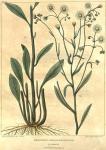 Also see Erigeron Heterophyllum. Sweet-Scabious.
Also see Erigeron Heterophyllum. Sweet-Scabious.
Skevish. Philadelphia Flea-bane.
Erigeron Philadelphicum, L.
Sp. Pl. 1211.
Houttuyn. Pfl. Syst. 9. p. 325.
Willd. Sp. Pl. tom. 3. pars 3, p. 1957.
Mich. Fl. Boreali-Am. vol. 2. p. 123.
Pursh. Fl. Am. Sep. vol. 2. p. 532.
Coxe. Disp. 3d ed. p. 314.
Big. Fl. Bost. p. 194.
Pers. Syn. PI vol. 2. p. 430.
Ait. Hort. Kew. ed. 2. vol. 5. p. 32.
Muhl. Cat. Pl. Am. Sep. ed. 2. p. 76.
Barton's Collections, part 2. p. 46.
Bart. Prod. Fl. Ph. p. 79.
Erigeron.
Recept. nudum. Pappus pilosus. Cor. radii capillares (colorats).
Nat. Syst. Juss. Corymbiferae. Classis X. Ordo III.
Erigeron, L. * Virga aurea, T. * Aster, T. * Flores radiati ligulis linearibus numerosis. Calix oblongus irubricatus inaequalis. Pappus pilosus. Ligulae in aliis albidse aut purpurascentes; lutes in alii§, quarum insuper anthers nonnUnquam basi 2-setoss Inulas indicant.
Nat. Ord. Lin. Composite discoidea.
Classis Syngenesia. Ordo. Superflua. Lin. Syst.
Gen. Ch. Common calix oblong, cylindrical, imbricated; scales awl-shaped, erect, gradually longer, nearly equal in breadth. Cor. compound, radiated; florets of the disk all perfect, tubular, funnel-shaped, with an equal five-cleft limb; those of the radius female, ligulate, linear, awl-shaped, erect, for the most part entire. Stam. (in the tubular florets) Filaments five, capillary, very short; anthers forming a cylindrical tube. Fist, (in the tubular florets) Germen minute, crowned with hairs longer than its own corolla; style thread-shaped, the length of the hairs; stigmas two, oblong, revolute; the female or ligulate florets differ in having their corolla about as long as the hairs, and very slender stigmas. Peric. none, except the closed permanent calix. Seeds in the florets of the disk as well as of the radius oblong, small. Doivn long, capillary. Recept, naked, flat.
Obs. Dillenius observes that the innermost or central florets of the disk are generally males. One species has those of the radius destitute of a corolla.
Ess. Ch. Receptacle naked. Down simple. Florets of the radius linear, very narrow, numerous. Calix imbricated.
Ency.
Erigeron Philadelphicum, pubescens; foliis cuneato-oblongis rariter inciso-dentatis, caulinis semi-amplex= icaulibus, caule debili simpliei supeme corymboso, pedunculis elongatis unifloris, radiis capil-laceis calyce hemisphaerico duplo longioribus. Willd. Mich, et Pursh.
Descriptio Uberior.
Folia oblonga lanceolata basi cordata amplexicaulia subserrata, margine tenuissime cilliata. Corolla: purpurea capillares longitudine disci. Willd. p. 1958.
The genus, of which two species are now to be described, is the ηεριγερων of the ancient Greeks, from ηρ, the spring, and γερων, an old man, because the plants which gave rise to the name were hoary in the spring.
The Erigeron Philadelphicum is an herbaceous perennial plant, two or three feet in height much branched at the top. The root is branched, somewhat fibrous, and of a yellowish cast. The branches are pubescent. Radical leaves, ovate-lanceolate, on long petioles, and occasionally having one or two serratures. Upper leaves lanceolate, entire sessile, and somewhat amplexicaule. Flowers numerous, erect, situated on a large diffuse pannicle. Calix hemispherical. Florets of the ray capillary, whitish, or blue; sometimes purplish. It grows in the greatest profusion in all the fields near Philadelphia; and it ranges extensively throughout the United States, in similar places. It begins to flower in July, and continues blooming through the month of August. It should be collected for medical use while in flower.
Medicinal use, see Erigeron heterophyllum.
Table XX.
Fig. 1. Is a figure of the upper portion of Erigeron Philadelphicum, of the natural size, in flower. The blue variety is here represented, because of the greater facility of figuring blue than white flowers; at least of such a form as these. The white variety is more common.
2. The lower portion of the same, cut asunder at the asterisk.

